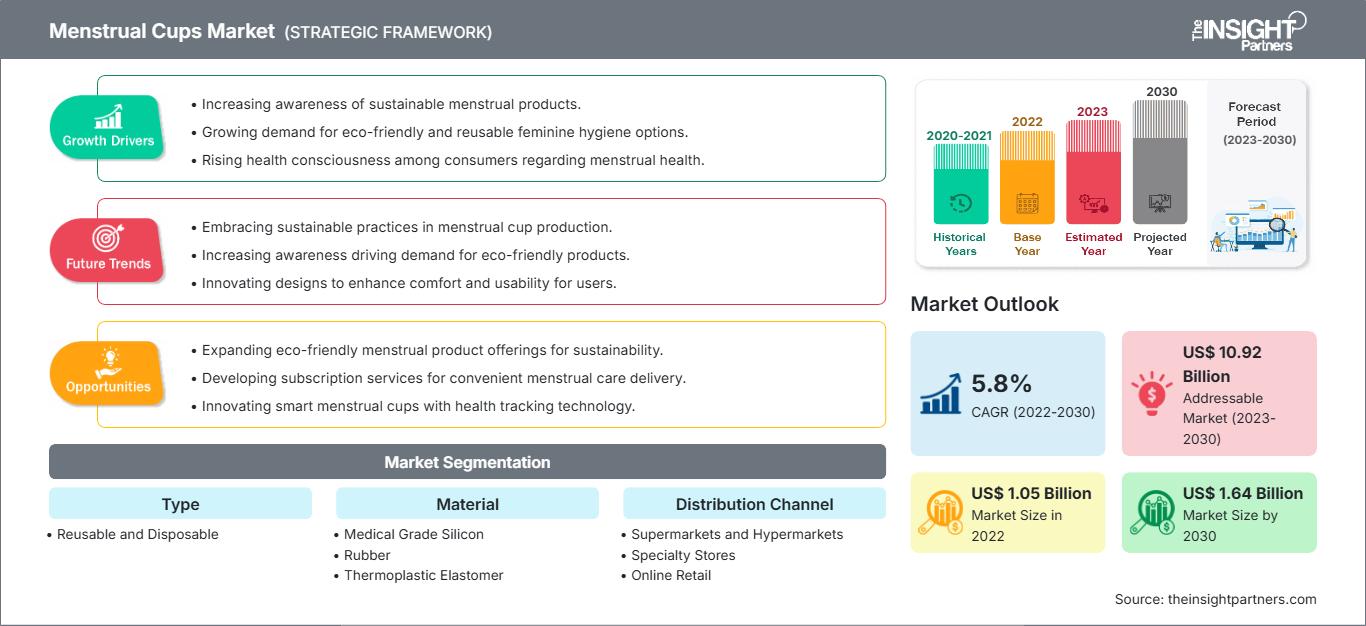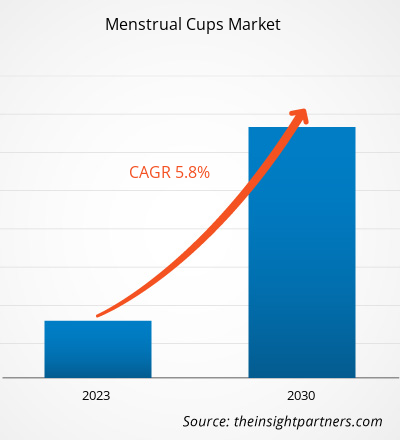[Forschungsbericht] Der Markt für Menstruationstassen hatte im Jahr 2022 ein Volumen von 1.050,81 Millionen US-Dollar und soll bis 2030 1.644,06 Millionen US-Dollar erreichen; von 2022 bis 2030 wird ein durchschnittliches jährliches Wachstum von 5,8 % erwartet.
Markteinblicke und Analystenmeinung:
Menstruationstassen sind wiederverwendbare, glockenförmige Hilfsmittel für die weibliche Hygiene während der Menstruation. Diese Tassen bestehen in der Regel aus medizinischem Silikon oder Gummi und werden in die Vagina eingeführt, um das Menstruationsblut aufzufangen, anstatt es wie herkömmliche Tampons oder Binden aufzusaugen. Sie dichten ab, um ein Auslaufen zu verhindern, und können bis zu 12 Stunden getragen werden, bevor sie entleert werden müssen. Sie bieten eine nachhaltige und kostengünstige Alternative zu Einwegprodukten. Menstruationstassen erfreuen sich aufgrund ihrer Umweltfreundlichkeit und der langfristigen Kostenersparnis im Vergleich zu herkömmlichen Menstruationshygieneprodukten zunehmender Beliebtheit.
Wachstumstreiber und Herausforderungen:
Die steigende Nachfrage nach nachhaltigen Menstruationsprodukten ist ein Haupttreiber für den Markt für Menstruationstassen. In den letzten Jahren hat weltweit ein Wandel hin zu mehr Nachhaltigkeit stattgefunden, und Verbraucherinnen werden sich zunehmend der Umweltauswirkungen herkömmlicher Einweg-Menstruationsprodukte bewusst. Herkömmliche Binden und Tampons tragen erheblich zum Plastikmüll bei, und ihre Herstellung verbraucht Ressourcen und Energie. Jedes Jahr wirft eine durchschnittliche Frau fast 150 Kilogramm nicht biologisch abbaubaren Abfall weg. Allein in Indien verwenden rund 121 Millionen Frauen und Mädchen durchschnittlich acht Einweg- und nicht kompostierbare Binden pro Monat, wodurch monatlich 1,021 Milliarden Bindenmüll, jährlich 12,3 Milliarden Bindenmüll und jährlich 113.000 Tonnen Menstruationsabfall entstehen. Menstruationstassen haben sich aufgrund ihrer Wiederverwendbarkeit als beliebte Wahl herausgestellt, da viele Menschen nach umweltfreundlichen Alternativen suchen. Dieses gestiegene Umweltbewusstsein veranlasst Verbraucherinnen, sich für Produkte mit minimalem ökologischen Fußabdruck zu entscheiden, was die Nachfrage nach Menstruationstassen steigert.
Die gestiegene Nachfrage nach nachhaltigen Menstruationsprodukten ist eng mit einer breiteren Bewegung verbunden, die sich für die Gesundheit und das Wohlbefinden von Frauen einsetzt. Verbraucherinnen legen zunehmend Wert auf Produkte, die nicht nur gut für die Umwelt, sondern auch sicher und gesundheitsfördernd sind. Menstruationstassen, die in der Regel aus medizinischem Silikon, Gummi oder thermoplastischen Elastomeren hergestellt werden, gelten als sicher und hygienisch und reduzieren das Risiko von Reizungen und allergischen Reaktionen, das bei herkömmlichen Produkten häufig auftritt. Die Ausrichtung von Menstruationstassen auf ökologische Nachhaltigkeit und Frauengesundheit trägt zu ihrer Attraktivität bei und ist ein Treiber für ihre steigende Beliebtheit.
Passen Sie diesen Bericht Ihren Anforderungen an
Sie erhalten kostenlos Anpassungen an jedem Bericht, einschließlich Teilen dieses Berichts oder einer Analyse auf Länderebene, eines Excel-Datenpakets sowie tolle Angebote und Rabatte für Start-ups und Universitäten.
Markt für Menstruationstassen: Strategische Einblicke

-
Holen Sie sich die wichtigsten Markttrends aus diesem Bericht.Dieses KOSTENLOSE Beispiel umfasst Datenanalysen, die von Markttrends bis hin zu Schätzungen und Prognosen reichen.
Der Ruf nach Nachhaltigkeit bei Menstruationsprodukten wurde von verschiedenen Interessengruppen, NGOs und Regierungsinitiativen verstärkt, die das Bewusstsein für die Umweltauswirkungen von Einwegprodukten schärfen wollen. Kampagnen zur Förderung nachhaltiger Menstruation waren entscheidend, um die Öffentlichkeit über die Vorteile wiederverwendbarer Alternativen wie Menstruationstassen aufzuklären. Die zunehmende Sichtbarkeit und Unterstützung nachhaltiger Menstruationspraktiken trägt zu einem positiven Wandel der Verbrauchereinstellungen bei und fördert eine größere Akzeptanz und Verwendung von Menstruationstassen.
Die Nachfrage nach nachhaltigen Menstruationsprodukten wird auch von einer jüngeren Generation von Verbrauchern angeheizt, die umweltbewusste Entscheidungen priorisiert. Insbesondere Millennials und die Generation Z treiben die Nachfrage nach nachhaltigen und ethischen Produkten in verschiedenen Branchen, einschließlich der Körperpflege, voran. Das Bewusstsein und die Vorlieben dieser Bevölkerungsgruppen beeinflussen Markttrends, und Menstruationstassen passen als nachhaltige und zukunftsweisende Option gut zu ihren Werten. Da die Kaufkraft dieser Bevölkerungsgruppe weiter steigt, wird auch die Nachfrage nach Menstruationstassen steigen und ihre Position auf dem Markt als führendes nachhaltiges Menstruationsprodukt stärken.
Die Wahrnehmung und Unwissenheit der Verbraucher stellen jedoch erhebliche Hemmnisse auf dem Menstruationstassenmarkt dar und wirken sich auf die Akzeptanzraten weltweit aus. Viele Menschen sind aufgrund fehlender umfassender Aufklärungs- und Sensibilisierungskampagnen nicht über die Vorteile von Menstruationstassen informiert. Die Unkenntnis des Produkts und seiner Vorteile wie Kosteneffizienz, geringere Umweltbelastung und längere Tragedauer trägt dazu bei, dass potenzielle Anwenderinnen nicht von herkömmlichen Menstruationsprodukten umsteigen möchten. Dieser Mangel an Wissen kann zu Missverständnissen und Hemmungen führen und so die breitere Akzeptanz von Menstruationstassen als praktikable und praktische Alternative behindern.
Die Zurückhaltung bei der Verwendung von Menstruationstassen wurzelt häufig in Bedenken hinsichtlich des schwierigen Einführens und Entfernens. Viele Verbraucher empfinden den Lernaufwand bei der Verwendung von Menstruationstassen als Hindernis, da sie davon ausgehen, dass dies ein gewisses Maß an Geschick oder Komfort erfordert, über das sie möglicherweise nicht verfügen. Das mangelnde Verständnis für die einfache Anwendung und die potenziellen gesundheitlichen Vorteile von Menstruationstassen trägt zu dieser Befürchtung bei. Die Überwindung dieser Vorurteile und Missverständnisse erfordert gezielte Aufklärungsarbeit, um die Benutzerfreundlichkeit, den Komfort und die positiven Auswirkungen auf die Umwelt hervorzuheben. Indem diese Bedenken berücksichtigt und das Bewusstsein geschärft werden, kann der Markt dazu beitragen, Mythen zu zerstreuen und eine positivere Wahrnehmung von Menstruationstassen bei potenziellen Benutzerinnen zu fördern.
Segmentierung und Umfang des Berichts:
Der globale Markt für Menstruationstassen ist nach Typ, Material, Vertriebskanal und Geografie segmentiert. Nach Typ wird der Markt in wiederverwendbare und Einwegprodukte unterteilt. Nach Material wird der Markt in medizinisches Silikon, Gummi und thermoplastisches Elastomer unterteilt. Nach Vertriebskanal wird der Markt in Supermärkte und Verbrauchermärkte, Fachgeschäfte, Online-Einzelhandel und andere unterteilt. Geografisch ist der globale Markt für Menstruationstassen grob in Nordamerika, Europa, Asien-Pazifik, den Nahen Osten und Afrika sowie Süd- und Mittelamerika unterteilt.
Segmentanalyse:
Basierend auf dem Typ wird der Markt für Menstruationstassen in wiederverwendbare und Einwegtassen unterteilt. Das Segment der wiederverwendbaren Tassen wird zwischen 2022 und 2030 voraussichtlich die höchste durchschnittliche jährliche Wachstumsrate verzeichnen. Wiederverwendbare Menstruationstassen stellen eine nachhaltige und kostengünstige Revolution in der Menstruationshygiene dar. Diese glockenförmigen Tassen werden in der Regel aus medizinischem Silikon, Gummi oder thermoplastischen Elastomeren hergestellt und in die Vagina eingeführt, um das Menstruationsblut aufzufangen, anstatt es wie herkömmliche Tampons oder Binden aufzusaugen. Die Flexibilität und Weichheit des Materials sorgen für Komfort und Benutzerfreundlichkeit und passen sich der Anatomie der Benutzerin an. Wiederverwendbare Menstruationstassen können bis zu 12 Stunden getragen werden, bieten auslaufsicheren Schutz und ermöglichen den Benutzerinnen mehr Flexibilität bei der Bewältigung ihrer Periode. Einer ihrer größten Vorteile ist ihre Umweltverträglichkeit, da sie wiederverwendet werden können. Die Tassen reduzieren die Menge des produzierten Menstruationsabfalls erheblich und tragen so zu einer umweltfreundlichen Menstruationspflege bei. Darüber hinaus machen die langfristigen Kosteneinsparungen und der Komfort, keine Einwegprodukte regelmäßig kaufen zu müssen, wiederverwendbare Menstruationstassen zu einer zunehmend beliebten Wahl für Anwenderinnen, die nach nachhaltigen und praktischen Alternativen in der Menstruationshygiene suchen.
Regionale Analyse:
Der Markt für Menstruationstassen ist in fünf Schlüsselregionen unterteilt: Nordamerika, Europa, Asien-Pazifik, Süd- und Mittelamerika sowie Naher Osten und Afrika. Nordamerika dominierte 2022 den globalen Markt für Menstruationstassen, da der Markt in dieser Region auf 395,41 Millionen US-Dollar geschätzt wurde. Europa ist ein zweitgrößter Marktteilnehmer mit einem Anteil von über 30 % am Weltmarkt. Für den Asien-Pazifik-Raum wird zwischen 2022 und 2030 eine beträchtliche durchschnittliche jährliche Wachstumsrate von über 5 % erwartet. Der Anstieg der Nachfrage nach Menstruationstassen im asiatisch-pazifischen Raum kann auf verschiedene Faktoren zurückgeführt werden, darunter der zunehmende kulturelle Wandel, das zunehmende Bewusstsein und die wachsende Bedeutung der Frauengesundheit. In vielen asiatischen Ländern gibt es eine wachsende Bewegung, die Tabus rund um die Menstruation zu brechen.
Auswirkungen der COVID-19-Pandemie:
Die COVID-19-Pandemie behinderte den globalen Markt für Menstruationstassen zunächst aufgrund von Produktionsschließungen, Arbeitskräftemangel, Unterbrechungen der Lieferketten und finanzieller Instabilität. Die Betriebsunterbrechungen in verschiedenen Branchen aufgrund der durch den COVID-19-Ausbruch verursachten Konjunkturabschwächung schränkten das Angebot an Menstruationstassen ein. Darüber hinaus wurden zahlreiche Geschäfte geschlossen, was den Verkauf von Menstruationstassen einschränkte. Dennoch begannen die Unternehmen, an Boden zu gewinnen, da zuvor verhängte Beschränkungen 2021 in verschiedenen Ländern aufgehoben wurden. Darüber hinaus entspannte die Durchführung von COVID-19-Impfkampagnen durch Regierungen verschiedener Länder die Situation und führte zu einem Anstieg der Geschäftsaktivitäten weltweit. Mehrere Märkte, darunter der Markt für Menstruationstassen, verzeichneten nach der Lockerung der Ausgangssperren und Bewegungseinschränkungen ein Wachstum.
Menstruationstassen
Regionale Einblicke in den Markt für MenstruationstassenDie Analysten von The Insight Partners haben die regionalen Trends und Faktoren, die den Markt für Menstruationstassen im Prognosezeitraum beeinflussen, ausführlich erläutert. In diesem Abschnitt werden auch die Marktsegmente und die geografische Lage in Nordamerika, Europa, dem asiatisch-pazifischen Raum, dem Nahen Osten und Afrika sowie Süd- und Mittelamerika erörtert.
Umfang des Marktberichts über Menstruationstassen
| Berichtsattribut | Einzelheiten |
|---|---|
| Marktgröße in 2022 | US$ 1.05 Billion |
| Marktgröße nach 2030 | US$ 1.64 Billion |
| Globale CAGR (2022 - 2030) | 5.8% |
| Historische Daten | 2020-2021 |
| Prognosezeitraum | 2023-2030 |
| Abgedeckte Segmente |
By Typ
|
| Abgedeckte Regionen und Länder |
Nordamerika
|
| Marktführer und wichtige Unternehmensprofile |
|
Dichte der Marktteilnehmer für Menstruationstassen: Verständnis ihrer Auswirkungen auf die Geschäftsdynamik
Der Markt für Menstruationstassen wächst rasant. Die steigende Nachfrage der Endverbraucher ist auf Faktoren wie veränderte Verbraucherpräferenzen, technologische Fortschritte und ein stärkeres Bewusstsein für die Produktvorteile zurückzuführen. Mit der steigenden Nachfrage erweitern Unternehmen ihr Angebot, entwickeln Innovationen, um den Bedürfnissen der Verbraucher gerecht zu werden, und nutzen neue Trends, was das Marktwachstum weiter ankurbelt.

- Holen Sie sich die Markt für Menstruationstassen Übersicht der wichtigsten Akteure
Wettbewerbslandschaft und wichtige Unternehmen:
Nixit, Lunette Global, Lena Cup LLC, Diva International Inc., Saalt, Pixie Cup, June Cup, Cora, The Flex Company und Blossom Cup gehören zu den führenden Akteuren auf dem globalen Markt für Menstruationstassen.
- Historische Analyse (2 Jahre), Basisjahr, Prognose (7 Jahre) mit CAGR
- PEST- und SWOT-Analyse
- Marktgröße Wert/Volumen – Global, Regional, Land
- Branchen- und Wettbewerbslandschaft
- Excel-Datensatz
Aktuelle Berichte
Erfahrungsberichte
Grund zum Kauf
- Fundierte Entscheidungsfindung
- Marktdynamik verstehen
- Wettbewerbsanalyse
- Kundeneinblicke
- Marktprognosen
- Risikominimierung
- Strategische Planung
- Investitionsbegründung
- Identifizierung neuer Märkte
- Verbesserung von Marketingstrategien
- Steigerung der Betriebseffizienz
- Anpassung an regulatorische Trends






















 Kostenlose Probe anfordern für - Markt für Menstruationstassen
Kostenlose Probe anfordern für - Markt für Menstruationstassen